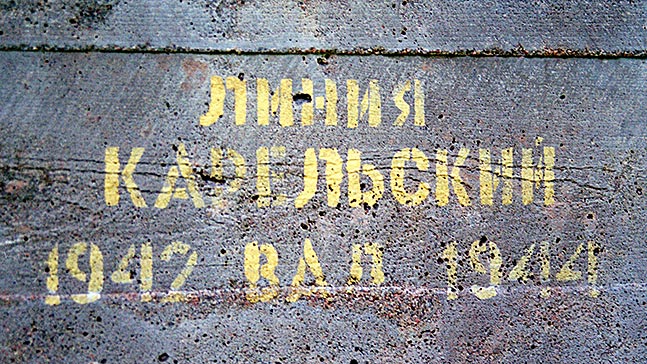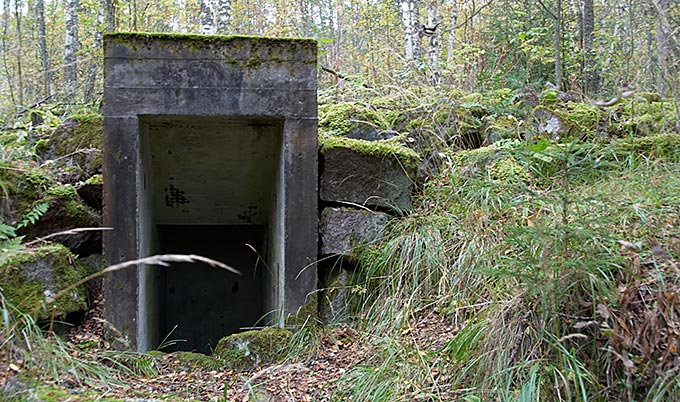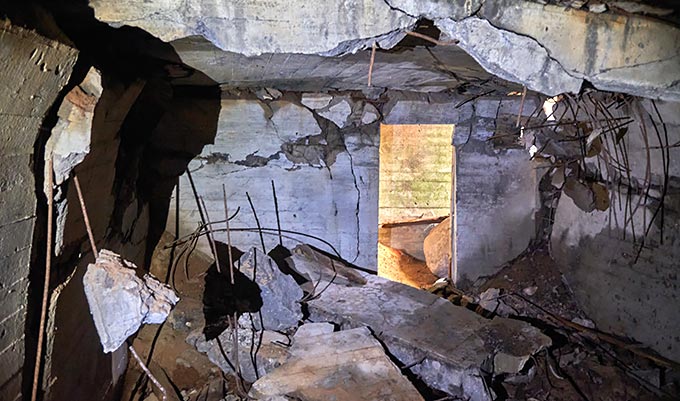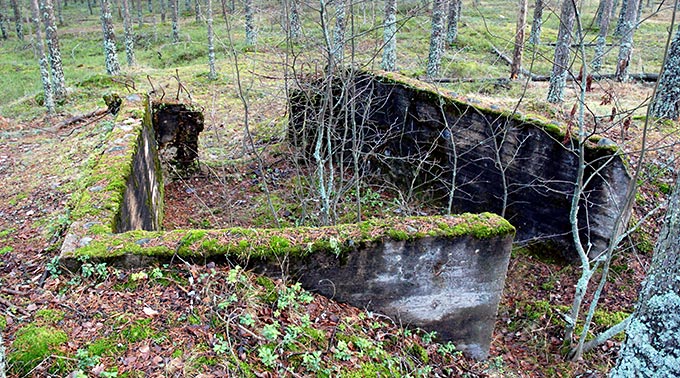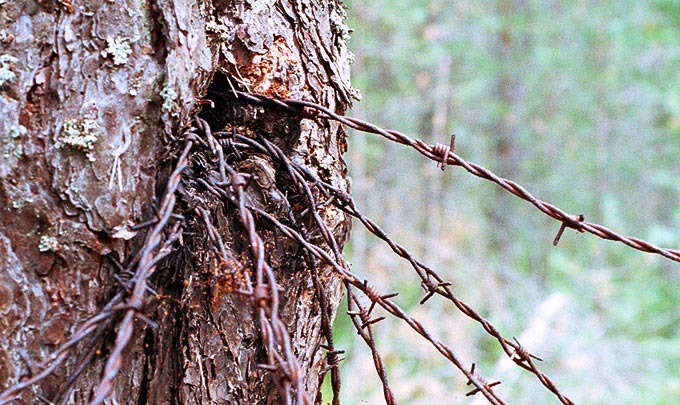History VT-line (Vammelsuu-Taipale Linja)
VT Line (Vammelsuu-Taipale defence line or Karelian Rampart) - is the chain of defence installations constructed by Finns in 1942-44. It lies across the Karelian Isthmus from Ladoga Lake to the Gulf of Finland. It never has been finished - there are piles of petrified cement and rusty armature wire for installations in many places along the Line.
VT Line consist of almost continuous lines of entrenchments with concrete infantry shelters for 15-20 man, concrete command and observation points, concrete machine gun positions. There were also few big machine gun's and gun's pillboxes grouped on the important heights and roads.
Trenches were covered by 2-3 rows of barbed-wire obstacles and 2-4 rows of anti-tank obstacles of huge granite rocks up to 1.5 meters dimensions. The rows of these rocks often were in 1 meter depth ditches with breastwork to the enemy side. There was not operational depth in the VT Line except Kivennapa and Kuuterselkä sectors.
VT line had more than 900 installations of various types, vast minefields, armoured small-arms positions in the trenches etc. There was railway along the line for quick reinforcements.
Morning of June, 9, 1944 big Soviet offensive on the Karelian Isthmus began. The sounds of Soviet artillery were heard at the Finnish General Headquarters in Mikkeli. Soviet 21 and 23 Armies had 7500 guns and mortars, 1000 fighting planes, 630 tanks and assault guns and near to 260000 soldiers. There was overwhelming superiority of Soviet side, and Finns were taken by surprise also.
June, 10 first line of Finnish defence (10 infantry division - ID) was broken near to Valkeasaari (Beloostrov). June, 12 Soviet troops (30 guardian corps and 98 corps) reached VT lines at the Kivennapa (Pervomajskoe) and Siiranmäki sectors, but were repulsed by Finns (11 infantry regiment - IR of 3 ID, 7 and 49 IRs of 2 ID, 6 IR of 18 ID, and Estonian volunteers of 200 IR) and had a considerable casualties.
After that reinforcement by 108 corps and regrouping of Soviet troops were made and June, 14 powerful strike was made at Kuuterselkä (Lebjajee) - Sahakylä (Mukhino) sectors of VT Line. Finns (53 and 48 IRs) were driven back and Soviet tanks penetrated in the break of the Line and flanked the Finnish units. Finns undertook the desperate counterattack with the support of battalion of assault guns Sturmgeschutz III, but were repulsed and failed. June, 17 Soviets reached the rear line of Finnish defence near to ruined Mannerheim Line.
July, 17 Finnish troops abandoned VT Line and began to retreat to VKT Line (Viipuri-Kuparsaari-Taipale defence line). There were severe rear-guard fightings during the retreat. It was the end of war history of VT Line.
Finally in the end of 1940's all remained installations of VT Line were blown up by Soviet pioneer units thoroughly. Now VT Line is ruined, overgrown with shrubs and woods and completely forgotten.
Impressions
There are no impressive or remarkable objects especially as compared with Mannerheim Line, KaUR or Salpa-Line. The trenches, anti-tank obstacles, teared barbed wires, mossed concrete wreckages forms common pictures of this places. But all of this extends near to continuously from Ladoga to Finnish Gulf and inspires with respect of it's large scale and dimensions.
There are huge number of concrete installations of various types mainly shelters, pillboxes, observation points etc. All of it was blown up utterly.
Some places can not be reached without axe or machete because of jungle (it is not Vietnam in full meaning, but we have here some suitable places for arrangement of partizan hell too).
Land forts and fortress:
Bip Castle Gatchina Ivangorod Izborsk Kexholm Kirillov Monastery Koporye Novgorod Pechorskiy Monastery Peter&Paul Fortress Porkhov Pskov Schlisselburg Staraya Ladoga Tikhvin Vyborg Hameenlinna Hamina Kastelholm Kymenlinna Lappaenranta Raseborg Castle Savonlinna Tavetti Turku Visby Fredrikstadt Fredriksten Hegra Fort Hoytorp Fort Arensburg Narva Tallinn Antipatris Caesarea Jerusalem Latrun Fort Masada
Sea forts and fortresses:
Alexander Fort Ino Fort Krasnaya Gorka Fort Kronstadt: Kotlin isl. Kronstadt: North Forts Kronstadt: South Forts Trongsund Hanko Svartholm Sveaborg Marstrand Siaro Fort Vaxholm Oscarsborg
Artillery batteries and individual guns:
Coastal Artillery Hemso Fort
Fortified areas and defensive lines:
Karelian Fortified Area (KaUR) KrUR Leningrad Mannerheim Line Nevsky Bridgehead VT Line Harparskog Line Salpa Line Gothland
Russian
S e a r c h All news

